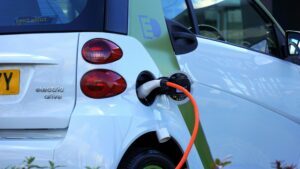How 3D Printing Drives Innovation in the Automotive Industry: Case Studies and Applications

Explore the transformative role of 3D printing in the automotive industry. Discover case studies and cutting-edge applications that reveal how this technology revolutionizes design, production, and efficiency in modern vehicles.
3D Printing’s Role in Automotive Transformation
3D printing, also known as additive manufacturing, has introduced a groundbreaking shift in how automotive companies design, test, and manufacture components and vehicles. Unlike traditional methods, which involve cutting or machining materials to create shapes, 3D printing builds objects layer by layer, offering immense design flexibility and precision. For the automotive industry—where efficiency, innovation, and sustainability are critical—3D printing presents unparalleled advantages.
Automotive manufacturers have begun adopting 3D printing for rapid prototyping, low-volume production, customized parts, and even end-use components, resulting in faster development cycles and cost savings. This article delves into the significant applications of 3D printing in the automotive world, exploring several detailed case studies, the technology’s advantages, and its future potential in driving industry innovation.
Case Study 1: Prototyping Innovations at Ford
Ford Motor Company has been a pioneering force in integrating 3D printing into automotive design and manufacturing, particularly in prototyping. In traditional automotive prototyping, creating a single part could take weeks, as specialized molds were often needed for each design iteration. With 3D printing, Ford has drastically reduced the time required to prototype parts, allowing their engineers to experiment with more designs in less time and at a fraction of the cost.
One notable example is the intake manifold for the Ford GT, a high-performance sports car. By 3D printing this complex component, Ford’s engineers could optimize the design to improve airflow, directly enhancing the engine’s efficiency and power. They were able to test multiple designs rapidly, ultimately selecting the version that provided the best balance between performance and durability.
Additionally, Ford has established multiple advanced 3D printing labs where engineers and designers work collaboratively to produce and test thousands of prototype parts annually. These facilities allow for rapid iteration, where adjustments can be made and tested within days rather than weeks, accelerating the design phase and reducing the time to market. Ford’s success with 3D printing in prototyping illustrates the immense value of additive manufacturing for automotive innovation.
Case Study 2: Customized Parts for Porsche’s Classic and Performance Vehicles
Porsche has used 3D printing extensively to create custom components for high-performance and classic cars. In the luxury automotive sector, personalization and precision are essential, and 3D printing offers a level of customization that traditional manufacturing methods struggle to match. For Porsche, 3D printing provides an ideal solution to create bespoke parts for clients with unique needs, especially when manufacturing small batches of specialized components for limited-edition or vintage models.
One of the standout applications at Porsche is the 3D-printed piston for its high-performance sports cars. This advanced piston design is not only more durable but also about 10% lighter than those manufactured using traditional casting techniques. The lighter weight reduces stress on the engine and increases efficiency, enhancing the overall performance of Porsche’s racing and sports vehicles. By using additive manufacturing, Porsche has also been able to create pistons with optimized designs that improve combustion within the engine, further boosting horsepower and efficiency.
Porsche also uses 3D printing to produce parts for classic models, where sourcing or manufacturing traditional components can be challenging. Through additive manufacturing, Porsche can make exact replicas of discontinued parts, ensuring that older models can remain in operation. This capability highlights 3D printing’s potential to extend the life of classic cars, meeting the needs of automotive enthusiasts and collectors alike.
Case Study 3: Volkswagen’s Use of 3D Printing for Tooling and Fixtures
While 3D printing is often associated with end-use parts, Volkswagen has harnessed it for producing tools, fixtures, and jigs used in its assembly lines. The manufacturing of these tools typically involves custom designs and precision engineering, which can be time-consuming and costly. With 3D printing, Volkswagen has streamlined this process, reducing the time and expense required to produce these essential components.
Volkswagen started its 3D printing initiative at their Wolfsburg plant, where they printed custom fixtures for assembling vehicle parts. These fixtures ensure that components are placed accurately and securely during the assembly process, which reduces the likelihood of human error and boosts the efficiency of the production line. By customizing the tooling and fixtures for specific models and processes, Volkswagen has improved the flexibility of its assembly lines, allowing them to adapt quickly to new car models.
The use of 3D-printed tooling has also significantly reduced Volkswagen’s tooling costs. Traditional tooling often involves specialized machines and manual labor, leading to high production expenses. With 3D printing, Volkswagen can create tools on demand, only producing what’s needed and modifying designs with minimal lead time. This flexibility allows Volkswagen to respond quickly to changes in production and new vehicle designs, highlighting the strategic advantages of 3D printing in automotive manufacturing.
Benefits of 3D Printing in the Automotive Industry
1. Rapid Prototyping and Design Flexibility
One of the most valuable applications of 3D printing in the automotive industry is rapid prototyping. This technology allows engineers and designers to experiment with complex shapes and new ideas without the lengthy setup times associated with traditional manufacturing methods. With 3D printing, a prototype can be produced in hours or days rather than weeks, allowing for more testing and innovation. This quick turnaround enhances design flexibility and makes it easier for automakers to bring new ideas to market faster.
2. Cost Savings in Production
Manufacturing automotive parts can be expensive, especially for low-volume or customized components. 3D printing reduces production costs by minimizing material waste, eliminating the need for molds, and offering on-demand production. This is especially beneficial for producing complex or low-volume parts that would otherwise require costly tooling. For example, Porsche’s 3D-printed pistons are produced more affordably and with optimized designs, resulting in both cost and performance benefits.
3. Lightweight Components for Enhanced Fuel Efficiency
Fuel efficiency is a major focus for the automotive industry, and reducing vehicle weight is a key strategy to achieve it. 3D printing enables manufacturers to create complex, lightweight structures that maintain the required strength and durability. By using advanced materials and optimized designs, automakers can produce components that are lighter than their traditionally manufactured counterparts, ultimately enhancing fuel economy, performance, and handling.
4. On-Demand Production and Inventory Reduction
3D printing allows manufacturers to produce parts as needed, reducing the need for large inventories and minimizing storage costs. For rare or obsolete parts, such as those for classic vehicles, 3D printing provides a solution to supply these items without requiring mass production. This on-demand capability also helps manufacturers respond to changes in customer demand more flexibly, ensuring a quick turnaround for customized or replacement parts.
5. Reduced Environmental Impact
The automotive industry is striving to reduce its environmental footprint, and 3D printing aligns with these goals by minimizing material waste. Traditional manufacturing methods often produce excess material that goes unused, while 3D printing builds parts with minimal waste. Additionally, the ability to produce lighter parts contributes to fuel efficiency, reducing vehicle emissions and aligning with stricter environmental regulations.
Future of 3D Printing in the Automotive Industry
1. Expansion of Materials for Enhanced Performance
As 3D printing technology advances, the development of new materials will continue to expand its applications in the automotive sector. High-strength polymers, advanced metal alloys, and biocompatible materials are being developed for use in automotive parts, allowing for a broader range of components to be produced with 3D printing. These materials enhance durability and performance, especially in parts that must endure extreme conditions, such as engine components or structural parts.
2. Integration of 3D Printing in Electric Vehicles (EVs)
The automotive industry is shifting toward electric vehicles (EVs), and 3D printing is likely to play a significant role in their production. Lightweight materials and customized designs are critical for EVs, as these factors directly affect battery efficiency and vehicle range. 3D printing allows manufacturers to produce lighter, more efficient parts for EVs, optimizing battery performance and extending vehicle lifespan.
3. Increased Adoption of Digital Manufacturing Processes
3D printing is part of a broader trend toward digital manufacturing, which includes automation, data-driven design, and digital twins. By integrating 3D printing with these technologies, automakers can achieve higher precision, faster production, and improved quality control. This digital approach allows for more efficient production processes, greater flexibility, and better responsiveness to changes in demand or design requirements.
Frequently Asked Questions (FAQs)
Q1: How does 3D printing save costs for automotive manufacturers?
3D printing reduces production costs by minimizing material waste, eliminating the need for expensive molds, and enabling on-demand manufacturing. This is particularly cost-effective for low-volume or customized parts.
Q2: Is 3D printing reliable for high-performance car parts?
A: Yes, depending on the materials and design. 3D printing can produce strong, durable parts using advanced polymers and metals, making them suitable for high-performance applications.
Q3: How does 3D printing improve fuel efficiency in vehicles?
A: By enabling the production of lightweight components, 3D printing helps reduce vehicle weight, which improves fuel efficiency and overall performance.
Q4: Are 3D-printed car parts as durable as traditionally manufactured ones?
A: When produced with the right materials and processes, 3D-printed parts can be as durable as traditional ones, with the added benefit of optimized designs for specific uses.
Q5: What role does 3D printing play in the electric vehicle industry?
3D printing is used to produce lightweight, custom components that enhance EV battery efficiency and reduce overall vehicle weight, helping to increase driving range.
Q6: How does 3D printing benefit automotive prototyping?
It allows manufacturers to quickly create prototypes, test multiple designs, and make adjustments, accelerating development cycles and enhancing product quality.
Q7: Is 3D printing used for mass production in the automotive industry?
A: While 3D printing is mainly used for prototyping, tooling, and low-volume parts, advancements in technology may allow for mass production in the future.
Q8: Can 3D printing help produce parts for discontinued car models?
A: Yes, it’s particularly useful for classic cars, as manufacturers can recreate rare parts without needing mass production, supporting restoration and maintenance.
Q9: What materials are commonly used for 3D printing in the automotive industry?
A: Advanced polymers, metal alloys, and composite materials are commonly used to produce durable and lightweight parts.
Q10: How does 3D printing align with environmental goals in automotive manufacturing?
A: By reducing material waste and enabling the production of lighter, fuel-efficient components, 3D printing supports efforts to reduce the automotive industry’s environmental impact.
3D Printing’s Transformative Impact on the Automotive Industry
3D printing is revolutionizing the automotive industry by enhancing design flexibility, reducing production costs, and enabling innovative solutions for customized, high-performance vehicles. We see how additive manufacturing is being applied across the sector through case studies from industry leaders like Ford, Porsche, and Volkswagen. As 3D printing technology advances, its integration into the automotive industry will likely grow, bringing greater efficiency, sustainability, and performance to the vehicles of tomorrow.





